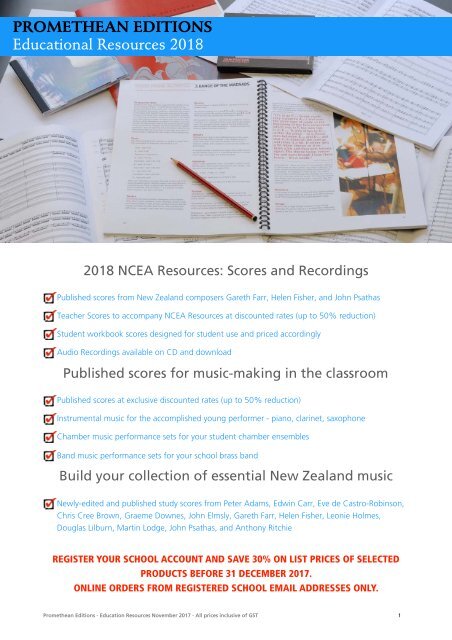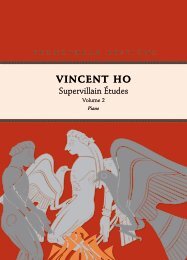Create successful ePaper yourself
Turn your PDF publications into a flip-book with our unique Google optimized e-Paper software.
PROMETHEAN EDITIONS<br />
<strong>Educational</strong> <strong>Resources</strong> <strong>2018</strong><br />
<strong>2018</strong> NCEA <strong>Resources</strong>: Scores and Recordings<br />
Published scores from New Zealand composers Gareth Farr, Helen Fisher, and John Psathas<br />
Teacher Scores to accompany NCEA <strong>Resources</strong> at discounted rates (up to 50% reduction)<br />
Student workbook scores designed for student use and priced accordingly<br />
Audio Recordings available on CD and download<br />
Published scores for music-making in the classroom<br />
Published scores at exclusive discounted rates (up to 50% reduction)<br />
Instrumental music for the accomplished young performer - piano, clarinet, saxophone<br />
Chamber music performance sets for your student chamber ensembles<br />
Band music performance sets for your school brass band<br />
Build your collection of essential New Zealand music<br />
Newly-edited and published study scores from Peter Adams, Edwin Carr, Eve de Castro-Robinson,<br />
Chris Cree Brown, Graeme Downes, John Elmsly, Gareth Farr, Helen Fisher, Leonie Holmes,<br />
Douglas Lilburn, Martin Lodge, John Psathas, and Anthony Ritchie<br />
REGISTER YOUR SCHOOL ACCOUNT AND SAVE 30% ON LIST PRICES OF SELECTED<br />
PRODUCTS BEFORE 31 DECEMBER 2017. <br />
ONLINE ORDERS FROM REGISTERED SCHOOL EMAIL ADDRESSES ONLY.<br />
Promethean Editions - Education <strong>Resources</strong> November 2017 - All prices inclusive of GST 1
Study New Zealand Composers with essential published<br />
scores and exclusive discounts for teachers<br />
Gareth Farr is one of New Zealand’s most exciting and colourful composers of contemporary classical music. His<br />
work is vibrant, energetic, percussive and extremely accessible – students love it! Feature Gallipoli this year with<br />
Farr’s Onslaught for brass band and percussion, newly published in 2015 as a study score, conductor’s score and<br />
complete set of 30 performance parts. Another recent publication of Farr’s is Balinese Pieces, a set of three<br />
piano works influenced by gamelan music of Indonesia – exciting music that advanced piano students are sure<br />
to enjoy. We also have scores available for three of Farr’s essential works – Sea Gongs, Kembang Suling and<br />
Volume Pig.<br />
Olympic composer John Psathas’ music is unique in fusing elements of rock and jazz along with the music of his<br />
Greek heritage into a new contemporary classical style. Understand Psathas’s latest music in context by studying<br />
the published scores for his three ground-breaking concerti – Omnifenix, Three Psalms and View from Olympus –<br />
and chamber works Drum Dances and Abhisheka.<br />
Another NCEA favourite is Pounamu by Helen Fisher – steeped in the sounds of European and Maori musical<br />
traditions, this bi-cultural mixture has brought new experiences to performers and audiences worldwide. We<br />
have available the published score and performance parts of Pounamu.<br />
New music for Brass Band and Percussion<br />
— Gareth Farr’s The Nor’west Arch and<br />
Onslaught<br />
PROMETHEAN EDITIONS<br />
GARETH FARR<br />
The Nor’West Arch<br />
Brass Band<br />
The Nor’west Arch was commissioned by the Christchurch Arts Festival as a<br />
memorial to the 181 people who died in the February 2011 Christchurch<br />
earthquake. It is a highly emotive work with its combination of sustained chords<br />
and simple melodic lines that pass between single instruments throughout the<br />
band. The work can be enhanced with poignant text about the earthquake that<br />
can be spoken at specific points. Farr’s work can serve as a reflective highlight to<br />
any brass band programme.<br />
In 2004, the New Zealand Army Band commissioned Gareth Farr to write<br />
Onslaught to mark the 90th anniversary of the Battle of Gallipoli. As many New<br />
Zealanders know, 3000 New Zealand soldiers were part of an amphibious Allied<br />
invasion that took place at what is now known as Anzac Cove, on Turkey’s Gallipoli<br />
Peninsula, on 25 April 1915. Under heavy fire they made their way up the beach in<br />
an attempt to divert and prevent Turkish forces from strengthening their defence<br />
against the main Allied landing further south at Cape Helles. Among those that<br />
fought were the members of four New Zealand army bands. By the end of the<br />
fighting, the casualty rate was such that there was only one band’s worth of<br />
members left alive. Onslaught communicates on a strongly physical and visceral<br />
level in its portrayal of the intensity and chaos of battle.<br />
PROMETHEAN EDITIONS<br />
GARETH FARR<br />
Onslaught<br />
Brass Band<br />
Promethean Editions - Education <strong>Resources</strong> November 2017 - All prices inclusive of GST 2
Douglas Lilburn<br />
occupies a preeminent<br />
position<br />
in New Zealand<br />
music, with a<br />
legacy extending<br />
well beyond his<br />
compositional<br />
output. As a<br />
composer, teacher<br />
and mentor<br />
he presided in<br />
artistic growth of New<br />
. From the early works<br />
f Sibelius and Vaughan<br />
oustic pieces of his<br />
een instrumental in<br />
acular in New Zealand<br />
ilburn’s first major<br />
ten while he was a<br />
Vaughan Williams at the<br />
ondon. The work won<br />
nd National Centennial<br />
s more recently become<br />
rchestral repertoire with<br />
ecordings presented<br />
ony Orchestra. This<br />
olumes published in<br />
y of Lilburn’s birth in<br />
ly<br />
ort<br />
the<br />
n.<br />
thean Editions Limited<br />
x 10-143<br />
gton New Zealand<br />
promethean-editions.com<br />
Douglas Lilburn<br />
occupies a preeminent<br />
position<br />
in New Zealand<br />
music, with a<br />
legacy extending<br />
well beyond his<br />
compositional<br />
output. As a<br />
composer, teacher<br />
and mentor<br />
he presided in<br />
innumerable ways over the artistic growth of New<br />
Zealand from 1940 onwards. From the early works<br />
redolent of the influence of Sibelius and Vaughan<br />
Williams, to the electro-acoustic pieces of his<br />
later years, his works have been instrumental in<br />
establishing a genuine vernacular in New Zealand<br />
classical music.<br />
For Lilburn’s only full-length choral work, Prodigal<br />
Country, the composer set three poems to<br />
music – Robin Hyde’s Journey from New Zealand,<br />
Allen Curnow’s New Zealand City and Walt<br />
Whitman’s Song of Myself. Across a single, winding<br />
movement, Prodigal Country conjures nostalgia<br />
and strangeness through its sung text and drifting<br />
melodic contours.<br />
ISMN 979-0-67452-205-2<br />
Printed in New Zealand • PEL22 • PNY PREPEL22<br />
Discover the new editions of Douglas Lilburn’s music<br />
Douglas Lilburn occupies a pre-eminent position in New Zealand music, with a legacy<br />
extending well beyond his compositional output. As a composer, teacher and mentor<br />
he presided in innumerable ways over the artistic growth of New Zealand from 1940<br />
onwards. From the early works redolent of the influence of Sibelius and Vaughan<br />
Williams, to the electro-acoustic pieces of his later years, his works have been<br />
instrumental in establishing a genuine vernacular in New Zealand classical music.<br />
Promethean Editions published five new editions in celebration of the centenary of<br />
Lilburn’s birth in 2015. This ‘centenary’ collection draws on the expertise of Dr Robert<br />
Hoskins, an Associate Professor at the New Zealand School of Music (retired), and Rod<br />
Biss, who as Production Director of Faber Music and then Price Milburn, was<br />
instrumental in first publishing Lilburn’s music in the 1970s. The editors, previous collaborators on the Douglas<br />
Lilburn Complete Piano Edition, have carefully considered and clarified Lilburn’s manuscripts and early<br />
publications in preparing these volumes as both scholarly and practical editions for performance.<br />
A Song of Islands for Orchestra (PEL23S)<br />
A Song of Islands (1946) is an essential work to study in the history of New Zealand<br />
orchestral music. This early work is a fine example of how Lilburn directly intended to<br />
capture the essence of New Zealand as a whole. Central to this work is a chorale-like theme<br />
that develops through an arch-like form. This critical edition is the first computer-engraved<br />
publication of the work.<br />
Douglas Lilburn<br />
A Song of Islands<br />
LilburN<br />
Edition<br />
veture<br />
DOUGLAS LILBURN Drysdale Overture PEL21<br />
Douglas LilburN<br />
Drysdale Overture<br />
Drysdale Overture for Orchestra (PEL21S)<br />
Lilburn was one of many New Zealand composers who travelled to<br />
England to continue their studies. He studied under the aegis of Ralph Vaughan Williams<br />
at the Royal College of Music in London. During his time in London he wrote his first major<br />
orchestral work, Drysdale Overture (1937). This remains as one of Lilburn’s quintessential<br />
works with its nostalgic portrayal of the New Zealand landscape. The work won first prize<br />
at the New Zealand National Centennial Competition in 1940 and more recently it has<br />
become established as a staple of orchestral repertoire with regular performances and<br />
recordings presented by the New Zealand Symphony Orchestra. Drysdale Overture is now<br />
available as a newly published study score, released in celebration of the centenary of Lilburn’s birth in 1915.<br />
Prodigal Country for Baritone, Chorus (SATB) and Orchestra (PEL22S)<br />
Douglas Lilburn<br />
Centenary Edition<br />
Prodigal Country<br />
For Lilburn’s only full-length choral work, Prodigal Country, the composer set three poems<br />
to music – Robin Hyde’s Journey from New Zealand, Allen Curnow’s New Zealand City and<br />
Walt Whitman’s Song of Myself. Across a single, winding movement, Prodigal Country<br />
conjures nostalgia and strangeness through its sung text and drifting melodic contours.<br />
The imagery of the river dominates the work, which, for Lilburn, seemed to represent<br />
freedom, while elsewhere Hyde’s evocative landscape is rugged and harsh, Curnow’s text<br />
emphasises the hesitancy and unease reminiscent of the Depression and Whitman’s<br />
romanticism is celebrated through Lilburn’s lyrical, melodic treatment.<br />
DOUGLAS LILBURN Prodigal Country PEL22<br />
Douglas Lilburn<br />
Prodigal Country<br />
Douglas Lilburn<br />
Symphony No.1<br />
Symphony No.1 for Orchestra (PEL24S)<br />
Lilburn’s Symphony No.1 (1949) is an essential work to study in the history of New Zealand<br />
orchestral music. Premiered in 1951 by the National Orchestra (now the New Zealand<br />
Symphony Orchestra), it was later established as a staple of orchestral repertoire with regular<br />
performances and recordings. This critical edition is the first computer-engraved publication of<br />
the work.<br />
Promethean Editions - Education <strong>Resources</strong> November 2017 - All prices inclusive of GST 3
#<br />
S<br />
C<br />
R<br />
C<br />
C<br />
S<br />
g<br />
C<br />
C<br />
C<br />
C<br />
g<br />
C<br />
S<br />
C<br />
C<br />
C<br />
S<br />
C<br />
S<br />
C<br />
C<br />
C<br />
S<br />
C<br />
C<br />
C<br />
C<br />
S<br />
C<br />
C<br />
C<br />
C<br />
B<br />
S<br />
C<br />
C<br />
C<br />
C<br />
C<br />
C<br />
S<br />
R<br />
S<br />
C<br />
C<br />
Lilburn Complete Piano Edition: Volumes 1–6<br />
Selected pieces in each of the six volumes are suitable for younger players, and all are ideal as featured<br />
works in recitals.<br />
Piano Music Vol.1 (PEL01)<br />
Piano Music Vol.4 (PEL04)<br />
This first volume comprises<br />
Lilburn’s highly individual<br />
Sonata (1949) and a collection<br />
of some 20 sketches, studies<br />
and personal tributes first<br />
published as Occasional Pieces<br />
in 1975.<br />
VOLUME 5<br />
Works for String Orchestra<br />
Piano Music Vol.2 (PEL02)<br />
Six Short Pieces (1962-63), his early Sonata for Piano<br />
in A minor (1939) and the miniature Moths and<br />
Candles (1948).<br />
Piano Music Vol.3 (PEL03)<br />
Lilburn’s Nine Short Pieces for Piano (1965-66), Three<br />
Sea Changes (1946-81), ‘Seven Short<br />
Pieces’ (1965-66), ‘Short Piece’ (1965), Prelude<br />
(1948), and Sonata (1956).<br />
Lilburn’s Sonatina No.1 (1946), ‘Short Piece’ (1965),<br />
Prelude (1948), ‘Untitled Piece’ (1965), Untitled<br />
Piece’ (1981), and A Musical Offering (1941).<br />
Piano Music Vol.5 (PEL05)<br />
Lilburn’s Chaconne (1946), ‘Six<br />
Pieces’ (1964), Three Preludes<br />
(1943), Fred’s Birthday (1965),<br />
and Rondino for a Birthday (c.<br />
1943).<br />
Douglas LilburN Piano Music 5<br />
VOLUME 5<br />
Works for String Orchestra<br />
Piano Music Vol.6 (PEL06)<br />
The sixth volume comprises<br />
Lilburn’s Sonata for Piano in F Sharp Minor (1939),<br />
‘Poco Lento’ (1960), The Young Pine Tree (1945),<br />
Hommage à D.A.F. (c.1965), Theme from ‘Variations<br />
on a Theme by Douglas Lilburn’ (1948), and<br />
‘Christmas 1942’ (1942).<br />
Piano Music from Gareth Farr<br />
Gareth Farr: Gem for Piano (PE136)<br />
18<br />
20<br />
! Y Y .<br />
Y Y Y Y Ċ Ċ X C . X .<br />
X C<br />
C C<br />
C C<br />
C C<br />
X C<br />
Y X X X X X X C C<br />
C C<br />
C C I<br />
X<br />
ppp<br />
mf<br />
pp<br />
Y Y Y Y Y Y g<br />
Y<br />
X<br />
C<br />
X X X X X X<br />
C C C C C C C O<br />
mp<br />
con pedale<br />
. Ċ Y C . Y C . Ċ Ċ Ċ Y C . C<br />
! 4<br />
5<br />
X<br />
ppp<br />
C C<br />
C C<br />
C C<br />
C C<br />
Ċ Ċ Y C C Y C<br />
C C<br />
C C<br />
I I<br />
mf<br />
pp<br />
# 4<br />
5<br />
X O C C C C C C O B S C O C C W<br />
C<br />
p<br />
X . Y . Y . Ċ Ċ Y . Y . C Y C C<br />
Y Y C C<br />
! 4 Y Y Y Y Y Y Y<br />
Gem was commissioned by pianist Nicola Melville, in memory of her teacher Judith Clark. This mysterious work<br />
Ċ Ċ Ċ 23<br />
is a contemplative rubato journey, predominantly along the black keys of the piano. Short flourishes of notes<br />
reach into the instrument’s<br />
X<br />
upper register, releasing notes in delicate droplets, particularly affecting when<br />
p C C<br />
C C<br />
Y C C<br />
Y<br />
Y<br />
I<br />
C C I<br />
pp ppp<br />
# W C C C O C 4 Q C C O C R<br />
Y Y Y Y Y Y Y<br />
Promethean Editions - Education <strong>Resources</strong> November 2017 - All prices inclusive of GST 4
#<br />
#<br />
#<br />
#<br />
#<br />
#<br />
C<br />
jh<br />
B<br />
C<br />
B<br />
C<br />
C<br />
CB<br />
> ><br />
C<br />
g<br />
C<br />
C<br />
C<br />
C<br />
C<br />
C<br />
h<br />
h<br />
C<br />
C<br />
C<br />
C<br />
C<br />
C<br />
T<br />
C<br />
CC<br />
CC<br />
h<br />
C<br />
C<br />
C<br />
CC<br />
C<br />
C<br />
h<br />
C<br />
g<br />
C<br />
C<br />
C<br />
C<br />
C<br />
C<br />
C<br />
C<br />
C<br />
g<br />
C<br />
C<br />
C<br />
C<br />
C<br />
C<br />
C<br />
T<br />
h<br />
g<br />
C<br />
C<br />
C<br />
C<br />
C<br />
C<br />
C<br />
g<br />
C<br />
C<br />
C<br />
C<br />
C<br />
C<br />
C<br />
g<br />
C<br />
C<br />
C<br />
C<br />
C<br />
C<br />
C<br />
C<br />
C<br />
CB<br />
><br />
C<br />
C<br />
C<br />
B<br />
B<br />
g<br />
g<br />
C<br />
C<br />
C<br />
C<br />
Ò<br />
C<br />
C<br />
h<br />
h<br />
C<br />
C<br />
C<br />
T<br />
C<br />
C<br />
B<br />
B<br />
Ò<br />
C<br />
C<br />
C<br />
h<br />
C<br />
C<br />
CC<br />
CC<br />
CC<br />
C<br />
C<br />
C<br />
C<br />
C<br />
C<br />
C<br />
g<br />
C<br />
39<br />
! Y Y C C C C C C C C C C C C C C C C C C C C C<br />
. . . .<br />
C C C C C C C C C C C C C C C C C C C C C C C C C C C C C C C C C C C C C C C C C<br />
. . . . . . . .<br />
C C C C C C<br />
B C O C C C<br />
decorating the work’s searching theme. Accelerated ascending runs lead to a climax of tumbling high register<br />
figures in contrary motion with the left hand.<br />
Y Y C<br />
O<br />
Gareth Farr: Balinese Pieces for Piano (PE128)<br />
42<br />
! Y Y C C C C C C C C C C C C C C C C C C<br />
. . . .<br />
C. C. C. C.<br />
Y Y C O<br />
Balinese Pieces (1996-2003) is a set of three piano works influenced by gamelan music of Indonesia and is<br />
47<br />
suitable for advanced school students of approximately Grade VIII and above. This set includes Sepuluh Jari (‘ten<br />
fingers’), ! Y Y Tentang O C<br />
Cara<br />
C C Gamelan (‘on the technique of gamelan’), and Jangan Lupa (‘don’t forget’). Farr perfectly<br />
C. C.<br />
C C B C O C C T C<br />
C C C C<br />
C C<br />
C<br />
A B C<br />
captures the exciting rhythms and beautiful sonorities of gamelan music and combines it with sounds and<br />
. . . . . . . . . . . . . . . . . . . .<br />
textures reminiscent of French impressionism. His writing for piano in these pieces is exciting, with fast melodic<br />
passages and complex rhythms. The three pieces can be performed together as a set or separately as standalone<br />
works. Balinese Pieces is sure to be a<br />
C C<br />
C C<br />
highlight in any piano recital programme.<br />
C C O<br />
C C C C<br />
52<br />
! Y Y C<br />
Instrumental C C C C C C C C C C C C C C C<br />
Music C C C C C C<br />
suitable C C C C C C C C C C C C C<br />
for C C C C<br />
student C C C C C C C<br />
performance C C C C C C C C C C C C C C C C C<br />
. . . . . . . . . . . .<br />
Gareth Farr: Meditation<br />
Y Y O<br />
O C C C C C O<br />
for Alto Sax and Piano (PE125)<br />
Peter Adams: Breath of Souls (UME11)<br />
This set of five waiata (songs or chants in Maori<br />
culture) draws inspiration from the natural and<br />
spiritual worlds described in the poem Mercy by<br />
Greek-Armenian 55<br />
poet Olga Broumas. Like the poem,<br />
Adams’ work similarly explores themes of love, loss<br />
and<br />
! Y Y C C C C C C C C C C C C C C C C C C C C C C C C C<br />
transcendence. The elegant arching structures<br />
and recurring . motives . derived . from . a 12-tone . row .<br />
make it a fascinating work for solo flute.<br />
Larry Pruden: Flight of the Albatross for Violin<br />
and Piano (PEP12)<br />
Larry Pruden’s Flight of the Albatross (1980) is an<br />
excellent 58 work for secondary students and above<br />
looking to perform lyrical contemporary music. It was<br />
! Y Y C C C C C C C C C C C C C C C C C C C C C C C C C C<br />
originally written as soundtrack music for a nature<br />
documentary and was later arranged especially for<br />
performance with young listeners in mind.<br />
John Psathas: Fragment<br />
for Vibraphone and Piano (PE076) <br />
for Vibraphone and Marimba (PE089)<br />
Fragment (2001) was originally written as a tribute to<br />
the composer’s first piano teacher on the occasion of<br />
his retirement. A gentle and delicate work, its<br />
atmospheric textures recall the second movement of<br />
View from Olympus, the double concerto for<br />
percussion and piano.<br />
><br />
B<br />
ig<br />
C O<br />
C. O C C C C. C O<br />
C<br />
C C C<br />
. . . . . . . . . .<br />
C C C C C C C<br />
C C C<br />
C C C B<br />
A A<br />
C<br />
C C C<br />
A<br />
Y Y C B C C C C C B C C O<br />
A A A A O<br />
Y Y C<br />
O<br />
.<br />
Y Y C O<br />
.<br />
C C C C C C<br />
.<br />
.<br />
C<br />
C<br />
C<br />
C<br />
C C C C C C C<br />
PE128 – 30<br />
for Viola and Piano (PE126)<br />
for Clarinet and Piano (PE127)<br />
Meditation (2004) is an ideal recital work for<br />
advanced C C C C C C C<br />
secondary C C C C C C<br />
school C C C C<br />
students C C C C C C C<br />
and C C C C<br />
above C C C<br />
looking to perform contemporary music. It was<br />
cresc. poco a poco<br />
originally . . written for . viola and . piano . and later . was<br />
adapted for both alto saxophone and clarinet. The<br />
work was written to highlight the C lyrical C C qualities of<br />
the solo instrument with a piano accompaniment. As<br />
such, Meditation provides an opportunity for the<br />
soloist to shine through individual expression, making<br />
it perfect for solo recitals and competitions.<br />
B C O<br />
C C C C C C C C C C C C C C C C<br />
C<br />
C<br />
Farr: Three Little Pieces for Eve for Percussion<br />
ff<br />
and Piano (PE095)<br />
“Serious fun” is the best way to describe this lively<br />
O<br />
and entertaining C set<br />
S<br />
of three contrasting pieces.<br />
C<br />
Gareth Farr wrote Three Pieces for Eve (2006) for the<br />
occasion of a friend’s birthday. It showcases Farr’s<br />
comic wit and clever writing. The percussionist uses<br />
household objects including bottles, flowerpots,<br />
mixing bowls and a triangle.<br />
><br />
B<br />
. .<br />
g<br />
C C<br />
C C C C C C C C C C C C C C C C C C C C C<br />
Promethean Editions - Education <strong>Resources</strong> November 2017 - All prices inclusive of GST 5
Anthony Ritchie: Meditation for Violin and<br />
Piano (UME03)<br />
Meditation (2008) is inspired by traditional Chinese<br />
folk music and poetry, and demonstrates Ritchie’s<br />
ongoing interest in exploring folk music traditions as<br />
a basis for creating new works. The violin part<br />
exploits expressive glissandi and high harmonics that<br />
recall the sound of the erhu, a bowed Chinese string<br />
instrument.<br />
Douglas Lilburn: Sings Harry for Baritone and<br />
Piano (PEL25)<br />
Lilburn’s Sings Harry (1953/1954) for baritone and<br />
piano is a setting of six poems by New Zealand poet<br />
Denis Glover. With simple yet precise word setting,<br />
Lilburn created spare and direct tunes with<br />
accompaniments that vividly evoke the rural New<br />
Zealand landscape and the characters that inhabited<br />
Glover’s poems. Also included are two previously<br />
unpublished settings by Lilburn of Glover’s poetry,<br />
‘Holiday Piece’ for medium voice and piano and ‘The<br />
Magpies’ for mixed voices.<br />
Gareth Farr: Waipoua for Clarinet and Piano<br />
(PE021)<br />
Waipoua is an excellent work for advanced<br />
secondary clarinet students who want to perform a<br />
lyrical solo work with piano accompaniment. Inspired<br />
by the composer’s visit to a state forest park, the<br />
work has a meditative quality that allows the<br />
performer to explore individual expression.<br />
Selected New Zealand chamber music for study<br />
Leonie Holmes: A Tedious Brief Scene: Bottom’s<br />
Dance (UME05S)<br />
This work is a fine example of Holmes’ work from her<br />
career as a composer and educator in New Zealand<br />
for over 25 years. Holmes was inspired to depict the<br />
character Bottom from Shakespeare’s A Midsummer<br />
Night’s Dream in writing this lighthearted work. It is<br />
highly engaging and energetic with elements of<br />
minimalist techniques of layered melodic ostinati,<br />
and jazz-influenced and non-tonal harmony.<br />
Graeme Downes: Introduction and Scherzo<br />
(UME09)<br />
This enigmatic and often playful work for harp<br />
incorporates scalar material reminiscent of the Blues,<br />
with unpredictable shocks of pedal glissandi<br />
peppering the Introduction with a chromatic motif.<br />
The Scherzo that follows presents a more animated<br />
working out of the Introduction’s materials, with<br />
polyrhythmic passages consisting of triplets grouped<br />
in fives, in addition to other rhythmic manifestations<br />
of the number five.<br />
Peter Adams: Look to the Far Horizon (UME16S)<br />
Look to the Far Horizon sees Adams attempt to<br />
capture some of the atmosphere and character of<br />
the skies and seascapes surrounding his home city of<br />
Dunedin, New Zealand, and the nearby Otago<br />
peninsula. Gentle clusters evoke the typically<br />
bleached skies and clouds of the Otago environment,<br />
while a simple modal tune introduces the building<br />
block from which everything is derived, its short<br />
note-long note rhythm sometimes transforming into<br />
a clipped “scotch snap”.<br />
Edwin Carr: Sonata for Solo Violin (UME10)<br />
The Sonata for Solo Violin (1969) demonstrates the<br />
consummate craftsmanship and refinement in Carr’s<br />
writing. Central to this work is an exploration of the<br />
melodic and expressive possibilities of the violin<br />
within the framework of a 12-tone system. The score<br />
also calls for extreme dynamic and registral changes,<br />
which adds to its virtuosic and challenging appeal as<br />
a highly expressive work. It is also intriguing to study<br />
as a representative 12-tone work in considering the<br />
reception of European modernism within New<br />
Zealand composition during the late 1960s.<br />
Anthony Ritchie: String Quartet No.2 (UME13S)<br />
Ritchie’s second string quartet is an impressive<br />
synthesis of sophistication and emotion. The first<br />
movement is dominated by energetic compound<br />
meters and rhythms, with motivic ideas derived from<br />
a magic square, while the second movement’s quiet<br />
rocking motion is pervaded by minor thirds, a<br />
common interval in children’s songs.<br />
Chris Cree Brown: Three Pieces for String<br />
Quartet (UME08S)<br />
These diverse works demonstrate a meticulous<br />
exploration of timbre and microtonality. It is inspired<br />
by the composer’s reflections on puberty and the<br />
contrast between child and adult worlds. This<br />
emerges in various ways, such as microtonal<br />
Promethean Editions - Education <strong>Resources</strong> November 2017 - All prices inclusive of GST 6
flourishes repeated as an obsession and the use of<br />
scordatura and harmonics to convey a sense of<br />
innocence, making for a fascinating collection. Chris<br />
Cree Brown is an Associate Professor of Music at the<br />
University of Canterbury, Christchurch, New Zealand.<br />
<br />
Martin Lodge: Works for Cello Solo and Duo<br />
(UME06)<br />
This set of four contrasting works, including three for<br />
cello duo and one for solo cello, exploits the wide<br />
registral and expressive qualities of the instrument to<br />
great effect. They also pay homage to senior New<br />
Zealand composers David Farquhar (1928-2007) and<br />
Douglas Lilburn (1915-2001) while showcasing the<br />
breadth of writing for cello in New Zealand.<br />
Orchestral Study Scores<br />
John Elmsly: Pacific Hockets (UME04S)<br />
This work stands out as one of Elmsly’s most<br />
important large-scale works from his career of over<br />
35 years. It contains a number of intriguing<br />
compositional devices that feature in much of his<br />
output. In this work Elmsly combines hocketing with<br />
minimalist additive and reductive processes, which<br />
creates a wide range of orchestral timbre. It is a<br />
fascinating work to study for the way in which he<br />
uses repetition and a variety of evolving rhythmic<br />
frameworks to develop the music in each of the<br />
three contrasting movements.<br />
Anthony Ritchie: Revelations (UME07S)<br />
Revelations (1998) is a journey through states of high<br />
tension and levity, influenced by Ritchie’s meditation<br />
on what happens to us after we die, and the neardeath<br />
experiences that suggest an answer to this<br />
question. After opening with an extended passage of<br />
dark drama led by writhing contours in the string<br />
section, the work is released into lighter material,<br />
eventually incorporating fanfare-like statements.<br />
Gareth Farr: Ruaumoko (PE041S)<br />
Based on the story of the Maori god of<br />
earthquakes, Ruaumoko sees Farr channeling the<br />
elemental forces of nature across four movements<br />
based on the four seasons. Tender woodwind playing<br />
is followed by perilous swirling contours and<br />
booming percussion, while elsewhere chiming<br />
pitched percussion, surging brass drones and<br />
interlocking choirs propel this dynamic work towards<br />
a triumphant finale.<br />
Anthony Ritchie: Symphony No.1<br />
‘Boum’ (UME14S)<br />
Boum is named after a mysterious echo heard by<br />
characters in E.M. Forster’s novel A Passage to India.<br />
The echo comes to symbolise the mysteries of life<br />
and death, and was a starting point to a general<br />
theme of existentialism and human struggle that<br />
pervades Ritchie’s symphony. An eclectic range of<br />
influences can be heard across Boum’s four<br />
movements.<br />
Anthony Ritchie: Symphony No.3 (UME01S)<br />
The driving force and subject of Anthony Ritchie’s<br />
third symphony is the idea of being human, which<br />
encompasses the full range of highs and lows of<br />
extreme emotions. This work reveals Ritchie’s highly<br />
personal and compelling writing, and extracts the<br />
inner world of human emotion as a heightened<br />
experience through the orchestra.<br />
Eve de Castro-Robinson: These arms to hold you<br />
(UME12S)<br />
Commissioned by the Royal Plunket Society, These<br />
arms to hold you channels both tender adoration and<br />
the excitement of a new arrival. The children’s choir<br />
maintains an expectant energy in this work with<br />
handclaps, overlapping chants, glissandi, ecstatic<br />
yelps and lullabies. Esteemed New Zealand poet Bill<br />
Manhire provided text for the choir, with excerpts<br />
taken from actual Plunket books heard alongside<br />
Manhire’s own prose. Castanets and temple blocks<br />
are made curious and playful in this setting as they<br />
provide a bubbling rhythmic drive for the orchestra. <br />
Promethean Editions - Education <strong>Resources</strong> November 2017 - All prices inclusive of GST 7
Student Workbook scores<br />
Replaceable workbook scores for students to annotate<br />
Promethean Editions - Education <strong>Resources</strong> November 2017 - All prices inclusive of GST 8


















